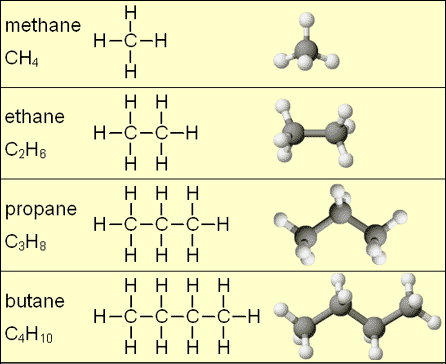Organic chemistry refers to the hydro-carbon bond between elements. There are millions of organic compounds out there, and each have different chemical and physical properties.
Carbon has 4 valence electrons, and it needs 4 more to fill its subshell. Therefore it forms bonds with other elements in order to be full and stable.
The 4 bonds of a carbon forms a tetrahydon, like this :

Hydrocarbons are the simplest organic compounds and they contain only carbon and hydrogen atoms.
ALKANES
Alkanes have the formula CnH2n+2 , meaning for every carbon atom, there are 4 hyrogen atoms. So if there were 2 carbon atoms, then there are 6 hydrogen atoms bonded with the carbon. Alkanes are different from others, because they are single bonds, and their suffix is -ane. So for example, C2H6, ethane, is an alkane with 2 carbons and 6 hydrogens.
Some common names include:
Methane CH4
Ethane C2H6
Propane C3H8
Butane C4H10
Pentane C5H12
Hexane C6H14
Heptane C7H16
Octane C8H18
Nonane C9H20
Decane C10H22

Properties of Alkanes
- Solid alkanes are normally soft with low melting points
- Insoluble in water
- Can exist in gases, liquids, and solids
ALKENES
Alkenes contain at least one double bond pair of carbon. The prefix of alkenes is the same as the prefix for alkanes, except the suffix changes from -ane to -ene. So Methane will become methene and so on.Alkenes follow the formula CnH2n.
So since propane has 3 carbons, and one of them is double bonded with another, then it will have 6 hydrogens instead of 8.
Properties of Alkenes
- Can be found in gases, liquids, and solids
- Insoluble in water
- Intermolecular forces of alkenes get stronger when the size of molecules increases

Alkenes have geometric isomers, meaning the order in which the elements are arranged can differ, yet still be symmetric.
ALKYNES
They are molecules that contain at least one triple-bonded carbon pair. Just like alkanes and alkenes, we use the same prefix; but the suffix changes to -yne instead of -ane or -ene.
So if we had butane that has a triple-bond carbon in it, the name will be butyne.
Properties of Alkynes
- Soluble in water and polar solvents
- High boiling points
- Strong acidity


No comments:
Post a Comment